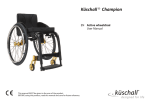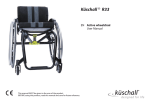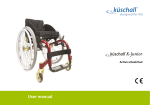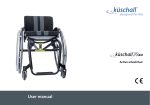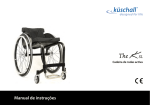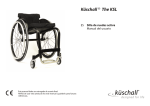Download User manual - Mobility for You
Transcript
Active wheelchair User manual This product complies with Directive 93/42/EEC concerning medical devices. © Küschall AG, Switzerland Every effort has been made to ensure that the contents of this publication are fully up-to-date at the time of going to print. As part of its ongoing improvement of products, Küschall® AG reserves the right to modify existing models at any time. Küschall® dealers will be notified of any such modifications. Any use of this publication, or of parts thereof, as well as any reproduction of images, must have the written consent of Küschall® AG. küschall® is a registered trademark. Content Contents 1 1.1 1.2 1.3 1.4 1.5 General Information about the User Manual Symbols Limitation of liability Copyright protection Warranty conditions 5 5 5 5 6 6 2 Safety 2.1 Safety information 2.2 Correct use 7 7 7 3 3.1 3.2 3.3 3.4 Technical data Dimensions and weight Environmental conditions Tyre pressure Identification label 8 8 9 9 9 4 4.1 4.2 4.3 4.4 4.5 4.6 Components and their function Overview Parking brakes Backrest cover Antitipper Seat cushion Accessories 10 10 11 12 12 13 13 5 6 6.1 6.2 6.3 Set-up Using the wheelchair Safety information Braking during use Getting in and out of the wheelchair 14 15 15 15 15 6.4 6.5 6.6 6.7 6.8 Driving and steering the wheelchair Negotiating steps and kerbs Going up and down stairs Negotiating ramps and slopes Stability and balance when seated 16 17 19 19 21 7 Transport 7.1 Safety information 7.2 Removing and fitting the rear wheels 23 23 23 8 8.1 8.2 8.3 8.4 25 25 25 28 28 Maintenance Safety information Maintenance schedule Cleaning Disinfection 9 Troubleshooting 9.1 Identifying and repairing faults 29 30 10 Adjustments and adaptations 10.1 Adjusting the footrest 31 31 11 After use 11.1 Re-use 11.2 Disposal 32 32 32 3 Content 4 General 1 General 1.1 Information about the User Manual Thank you for choosing a Küschall® wheelchair. This User Manual contains important information about using the wheelchair. In order to ensure safety when using your wheelchair, read the User Manual carefully and follow the safety information. The equipment of your wheelchair may differ from the descriptions and diagrams given here due to the wide range of models available. IMPORTANT Indicates a hazardous situation that could result in damage to property if it is not avoided. Tips and recommendations NOTE Gives useful tips, recommendations and information for efficient, trouble-free use. 1.3 Limitation of liability 1.2 Symbols All the information and warnings in this User Manual have been drawn up in accordance with current standards and regulations, the latest technological developments, and our expertise and experience over many years. Warnings Küschall AG accepts no liability for damage arising from: In this User Manual warnings are indicated by symbols. The warning symbols are accompanied by a heading that indicates the severity of the danger. Non-compliance with the User Manual WARNING Indicates a hazardous situation that could result in serious injury or death if it is not avoided. CAUTION Indicates a hazardous situation that could result in minor or slight injury if it is not avoided. Incorrect use Natural wear and tear Incorrect assembly or set-up by the purchaser or a third party Technical modifications Unauthorised modifications and/or use of unsuitable spare parts The written authorisation of Küschall AG must be obtained before installing additional adaptations on a Küschall wheelchair. Otherwise no liability claims can be made. 5 General 1.4 Copyright protection This User Manual is protected by copyright. It may not be reprinted or copied or transferred to third parties in part or in full without the prior written consent of the manufacturer. 1.5 Warranty conditions Warranty claims against Küschall AG may only be made by the distributor and not by the wheelchair user. The warranty conditions appear as a separate document in the sales documentation. 6 Safety 2 Safety This section contains important safety information for the protection of the wheelchair user and assistant and for safe, trouble-free use of the wheelchair. 2.1 Safety information WARNING! Risk due to driving style being unsuitable for the conditions There is a risk of skidding on wet ground, gravel or uneven terrain. Always adjust your speed and driving style to the conditions (weather, surface, individual ability, etc.). 2.2 Correct use The wheelchair is propelled manually and should only be used for independent or assisted transport of a disabled person with mobility difficulties. When used without an assistant, it should only be used by persons who are physically able to use the wheelchair safely (e.g. to propel themselves, steer, brake). The wheelchair should only be used indoors and on level ground and accessible terrain. WARNING! Any other or incorrect use of the wheelchair could lead to hazardous situations. WARNING! Risk of injury In a collision you could sustain injury to parts of your body that extend beyond the wheelchair (e.g. feet or hands). - Avoid an unbraked collision - Never drive into an object head-on - Drive carefully through narrow passages. WARNING! Risk due to wheelchair being out of control At high speed you could lose control of your wheelchair and overturn. - Never exceed a speed of 7 km/h. - Avoid collisions in general. 7 Technical data 3 Technical data 3.1 Dimensions and weight Seat width (SB) 34–42 cm Seat depth (ST) 37.5 / 40 / 42.5 cm Seat height front (SHv) 50 cm with 24‘‘ wheels Seat height rear (SHh) 38–48 cm Lower leg length (UL) 35-50 cm Seat angle (SW) variable 2–12 cm standard 7 cm Backrest height (RH) 30–46.5 cm Backrest angle (RW) 74°–90° 2) Total width (GB) SW + 23 cm Weight 3) 7 kg 1) 1) Total length (GL) 75°: Approx. 83 cm 90°: Approx. 76 cm Maximum user weight 100 kg At 3° wheel camber Depending on seat angle, lower leg length, rear wheel position and seat depth 3) With standard configuration, may vary (+/–) 2) 8 Technical data 3.2 Environmental conditions 3.4 Identification label Do not expose the wheelchair to temperatures below -20°C or above 40°C. The identification label is attached to the frame of your wheelchair and gives the following information: 3.3 Tyre pressure The ideal pressure depends on the tyre type: Tyre Max. pressure Low-resistance tyre 7 bar 700 kPa 101 psi Treaded tyre (marathon) 7.5 bar 750 kPa 108 psi Slick tyres (speed run) 10 bar 1000 kPa 145 psi 4 bar 400 kPa 58 psi 14 bar 1400 kPa 202 psi Mountain bike tyre Tubed tyre, carbon wheel IMPORTANT! The air pressure in tubed tyres on carbon wheels must be not less than 10 bar in order to prevent damage to the carbon rim. Inflate tubed tyres regularly using a suitable pump. Küschall AG Benkenstrasse 260 4108 Witterswil SWITZERLAND www.kuschall.com KÜSCHALL K-SL 2008 SB 40 cm 10/04/2009 Read User Manual 100 kg SN 01234567890 Active wheelchair, tipping backwards possible ! Manufacturer’s address Product description Date of manufacture Instruction to read the User Manual Maximum user weight Serial number Warning that this is an active wheelchair and can tip backwards. 9 Components and their function 4 Components and their function Removable axle Front wheel 4.1 Overview Footrest Brake Frame Seat cushion Clothes-guard Short description The KSL is a rigid frame wheelchair. NOTE The equipment of your wheelchair may differ from the diagram as each wheelchair is manufactured individually to the specifications in the order. Push handles Backrest Rear wheel with handrim 10 Components and their function 4.2 Parking brakes Performance brake The parking brakes are used to immobilise the wheelchair when it is stationary to prevent it from rolling away. WARNING! Risk of overturning If you apply the parking brakes while you are moving the wheelchair will stop suddenly. - Never apply the parking brakes while you are moving. The parking brakes will not operate correctly unless there is sufficient air in the tyres. (see Section 3.2 – Tyre pressure) Standard brake To apply the brake, push the brake lever forwards as far as possible. To release the brake, pull the brake lever backwards. To apply the brake, push the brake lever forwards as far as possible. To release the brake, pull the brake lever backwards. Active brake To apply the brake, pull the brake lever forwards beside or between your knees as far as possible. To release the brake, push the brake lever backwards beside or between your knees. 11 Components and their function 4.3 Backrest cover 4.4 Antitipper You can adjust the tension of the backrest cover as required. An antitipper prevents the wheelchair from tipping backwards. Adjusting the backrest cover Remove the backrest cushion. Loosen the Velcro® tapes on the rear of the backrest cover by simply pulling on them. Tighten or loosen the tapes as required then reattach them. 12 Activating the antitipper Push the antitipper downwards against the spring and swivel it backwards through 90° until it engages. CAUTION! Risk of tipping An activated antitipper can catch when negotiating a step or an edge. Always deactivate the antitipper before driving over a step or kerb. Components and their function Fitting a safety belt Deactivating the antitipper Push the antitipper downwards against the spring and swivel it inwards through 90° until it engages. Setting the height Press the spring pin on the antitipper and push the inner section to the position required. Allow the spring pin to engage in the nearest hole. 4.5 Seat cushion IMPORTANT Safety belts must be fitted by a specialist dealer. Remove the backrest cover and attach the Velcro® fastener to the backrest at the required height. Ensure that the fastener is at the front. Opening the safety belt Push in the PRESS button and pull the catch buckle . The safety belt opens. A suitable cushion is needed to provide an even pressure distribution on the seat. Closing the safety belt Push the catch into the buckle 4.6 Accessories Pull the belt wheelchair. Safety belt Your wheelchair can be fitted with a safety belt which will prevent you from falling out of the wheelchair. out of the until you are held securely in the Air pump The air pump is supplied with a valve adapter. Depending on the size of valve on your model, you may need to reverse the adapter on the pump’s air outlet. Remove the lock nut Remove the valve adapter Turn it around and reinstall it Replace the lock nut. Passive illumination You can attach 2 reflectors to the rear wheels. 13 Inbetriebnahme 5 Set-up CAUTION! Before using the wheelchair, check its general condition and its main functions. (See Section 8 – Maintenance) Your specialist dealer will supply your wheelchair ready for use. Your dealer will explain the main functions and ensure that the wheelchair meets your needs and requirements . 14 Using the wheelchair 6 Using the wheelchair 6.1 Safety information CAUTION! Risk of crushing There may be a very small gap between the rear wheel and the mudguard with the risk that you could trap your fingers. - Ensure that you always propel your wheelchair using the handrims only. CAUTION! Risk of crushing There may be a very small gap between the rear wheel and the parking brake with the risk that you could trap your fingers. - Ensure that you always propel your wheelchair using the handrims only. CAUTION! Risk of accidents Loose rear wheels or uneven tyre pressure can have a huge effect on handling. - Before each journey, check the tyre pressure and ensure that the rear wheels are securely attached. WARNING! Risk of overturning If you apply the parking brakes while you are moving the wheelchair may stop suddenly and you could fall out of it. CAUTION! The handrims (especially MaxGrepp and Supergripp) can get hot if you brake for a long time. There is a risk of burning your hands. - Wear suitable gloves. 6.3 Getting in and out of the wheelchair WARNING! Risk of overturning There is a high risk of overturning during the transfer. - Only get in and out without assistance if you are physically able to do so. WARNING! Risk of overturning The wheelchair could tip forwards if you stand on the footrest. - Never stand on the footrest when getting in and out. 6.2 Braking during use Whilst you are moving, you brake by transferring force to the handrim with your hands. Hold the handrims and press evenly with both hands until the wheelchair stops. CAUTION! If you release or damage the brakes the wheelchair could roll away out of control. - Do not support yourself on the brakes when getting in and out. 15 Using the wheelchair IMPORTANT! The mudguards and armrests could become damaged. - Never sit on the mudguards or armrests when getting in and out. Finding the tipping point Apply the parking brakes. Place your feet on the ground. Hold the wheelchair and, if necessary, also hold a fixed object in the vicinity. 6.4 Driving and steering the wheelchair You drive and steer the wheelchair using the handrims. Before driving without an assistant you must find your wheelchair’s tipping point. WARNING! Risk of tipping The wheelchair can tip backwards if it is not fitted with an antitipper . When finding the tipping point, an assistant must stand immediately behind the wheelchair to catch it if it tips over. To prevent tipping, install an antitipper device. CAUTION! A heavy load hanging on the backrest can affect the wheelchair’s centre of gravity. - Change your driving style accordingly. 16 Release the brake. Roll forwards a short distance, grasp both handrims firmly and pull backwards with a slight kick. The shift in weight and steering in opposite directions with the handrims will enable you to identify the tipping point. Using the wheelchair 6.5 Negotiating steps and kerbs With an assistant WARNING! Risk of overturning When negotiating steps you could lose your balance and tip the wheelchair over. - Always approach steps and kerbs slowly and carefully. - Do not go up or down steps that are higher than 25 cm. CAUTION An activated antitipper prevents the wheelchair from tipping backwards. - Deactivate the antitipper before going up or down steps or kerbs. Going down a step Move the wheelchair right up to the kerb and hold the handrims. The assistant should hold both push handles, place one foot on the tipper aid (if installed) and tilt the wheelchair backwards so that the front wheels lift off the ground. The assistant should then hold the wheelchair in this position, push it carefully down the step and then tilt it forwards until the front wheels are back on the ground. 17 Using the wheelchair Going up a step Move the wheelchair backwards until the rear wheels touch the kerb. The assistant should tilt the wheelchair using both push handles so that the front wheels lift off the ground, then pull the rear wheels over the kerb until the front wheels can be placed back on the ground. Without an assistant WARNING! Risk of tipping When going down a step without an assistant you could tip over backwards if you cannot control your wheelchair. - First learn how to go down a step with an assistant. - Learn how to balance on the rear wheels (Section 6.3). Going down a step Move the wheelchair right to the kerb, lift the front wheels and keep the wheelchair balanced. Now slowly roll both rear wheels over the kerb. While doing this, hold the handrims firmly with both hands until the front wheels are back on the ground. Going up a step Reverse the wheelchair until the rear wheels are on the kerb, lift the front wheels and keep the wheelchair balanced. Roll both rear wheels over the kerb and reverse until the front wheels can be placed on the ground. While doing this, hold the handrims firmly with both hands. 18 Using the wheelchair 6.6 Going up and down stairs WARNING! Risk of overturning When negotiating stairs you could lose your balance and overturn your wheelchair. - Always use 2 assistants when negotiating stairs with more than one step. 6.7 Negotiating ramps and slopes WARNING! Risk due to wheelchair being out of control When negotiating slopes or gradients your wheelchair could tip backwards, forwards or sideways. - Always have an assistant behind the wheelchair when approaching long slopes. - Avoid lateral slopes and - Avoid slopes of more than 7° - Avoid jerking when changing direction on a slope. CAUTION! Your wheelchair could run away even on slightly sloping ground if you do not control it using the handrims. - Use the parking brakes if your wheelchair is stationary on sloping ground. You can go up and down stairs by taking them one step at a time, as described above. The first assistant should stand behind the wheelchair holding the push handles. The second assistant should hold a solid part of the front frame to steady the wheelchair from the front. 19 Using the wheelchair Going up slopes Going down slopes To go up a slope, you must create some momentum, keep up the momentum and control the direction at the same time. When going down slopes, it is important to control your direction and particularly your speed. Bend your upper body forwards and propel the wheelchair with quick, powerful strokes on both handrims. Lean back and carefully allow the handrims to run through your hands. You should be able to stop the wheelchair at any time by gripping the handrims. Caution! Risk of burning The handrims (especially MaxGrepp and Supergripp) can get hot if you brake for a long time. You could burn your hands. - Wear suitable gloves. 20 Using the wheelchair 6.8 Stability and balance when seated Some everyday activities and actions require you to lean forwards, sideways or backwards out of the wheelchair. This has a major effect on the wheelchair’s stability. To keep your balance at all times, proceed as follows: Leaning forwards WARNING! Risk of falling out If you lean forwards out of the wheelchair you could fall out of it. Never bend too far forwards and do not shift forwards in your seat to reach an object. Do not bend forwards between your knees to pick up something off the floor. Point the front wheels forwards. (To do this, move your wheelchair forwards slightly then back again.) Apply both parking brakes. When leaning forwards your upper body must remain over the front wheels. Reaching backwards WARNING! Risk of falling out If you lean too far backwards you could tip your wheelchair over. Do not lean out over the backrest. Use an antitipper device. 21 Using the wheelchair Point the front wheels forwards. (To do this, move your wheelchair forwards slightly then back again.) Do not apply the parking brakes. When reaching backwards do not reach so far that you have to change your sitting position. 22 Transport 7 Transport 7.1 Safety information WARNING! Risk of injury if wheelchair is not secured during transport Your wheelchair is not designed for passenger transport in vehicles. You could suffer serious injury in an accident. - During transport, sit in a correctly secured seat, not in the wheelchair. IMPORTANT! Excessive wear and abrasion could affect the strength of load-bearing parts. - Do not pull your wheelchair across abrasive surfaces without the wheels fitted (e.g. pulling the frame over tarmac). Removing the rear wheels Release the brakes. With one hand, hold the wheelchair upright. 7.2 Removing and fitting the rear wheels CAUTION! The rear wheels could become loose during use if the removable axle is not fully engaged. Ensure that the removable axles are fully engaged whenever you fit a wheel. With the other hand, hold the spokes around the wheel hub. Press the removable axle button with your thumb, hold it down and pull the wheel out of the adapter sleeve. 23 Transport Fitting the rear wheels Release the brakes. With one hand, hold the wheelchair upright. With the other hand, hold the spokes around the wheel hub. Press the removable axle button with your thumb and hold it down. Push the axle into the adapter sleeve up to the stop. Release the removable axle button. The wheel is now securely in place. 24 Maintenance WARNING! Some materials deteriorate naturally over time. This could result in damage to wheelchair components. - Your wheelchair should be checked by a specialist dealer at least once a year or if it has not been used for a long period. Annually 8.1 Safety information Monthly Weekly 8 Maintenance Check tyre pressures Check that rear wheels are seated correctly Visual check Clean front wheels Your Küschall specialist dealer can provide help in carrying out regular maintenance. To find an authorised specialist dealer near you, contact the Küschall distributor for your country ( at the end of this document). 8.2 Maintenance schedule To ensure safe and reliable operation, carry out the following checks and maintenance regularly or have it carried out by another person. Check bolts Check spokes Check parking brakes Have wheelchair checked by the specialist dealer Checking the tyre pressure Check the tyre pressure ( Pressure table in Section 3 Technical data). Inflate the tyres to the required pressure. Check the tyre tread at the same time. If necessary, change the tyres ( Section 8.3). 25 Maintenance Checking that rear wheels are seated correctly Checking the spoke tension Pull on the rear wheel to check that the removable axle is seated correctly. The wheel should not come off. The spokes should not be loose or distorted. If the rear wheels are not engaged properly, remove any dirt or deposits. If the problem persists, have the removable axles re-fitted by a specialist dealer. Visual check Examine your wheelchair for loose parts, cracks or other defects. If you find cracks or damage, have your wheelchair checked immediately by a specialist dealer. Cleaning the front wheels Check that the front wheels turn freely. Remove any dirt or hair from the front wheel bearings. Checking the bolts Bolts can work loose through constant use. Check that the bolts are tight (on the front wheel supporter, footrest, seat cover, sides, adapter plate, backrest). Tighten any loose bolts. IMPORTANT! Safety nuts and bolts lose their effectiveness as a result of repeated loosening and tightening. Safety nuts and bolts should be replaced by a specialist dealer. 26 Loose spokes should be tightened by a specialist dealer. Broken spokes should be replaced by a specialist dealer. Checking the parking brakes Check that the parking brakes are positioned correctly. The brake is set correctly if the brake shoe depresses the tyre by no more than 4 mm when the brake is applied. To reset the parking brake, loosen the hexagon socket screw on the brake bracket and move the brake to the correct position. IMPORTANT The parking brakes must be reset after replacing the rear wheels or changing their position. Maintenance Repairing or changing tyres Remove the rear wheel and release any air from the inner tube. Lift one tyre wall away from the rim using a bicycle tyre lever. Do not use sharp objects such as a screwdriver which could damage the inner tube. Spare parts All spare parts may be obtained from a Küschall specialist dealer. A current list of spare parts is available on the internet at www.kueschall.com. Pull the inner tube out of the tyre Repair the inner tube using a bicycle repair kit or, if necessary, replace the tube. Inflate the tube slightly until it becomes round. Insert the valve into the valve hole on the rim and place the tube inside the tyre (the tube should lie right round the tyre with no creases). IMPORTANT! The carbon wheel has a tubed tyre which is bonded to the rim. The tyre on a carbon wheel should be replaced by a specialist dealer. Starting close to the valve, push the tyre wall over the edge of the rim using both hands. When doing this, check all the way round to ensure that the inner tube is not trapped between the tyre and the rim. Inflate the tyre to the maximum operating pressure. Check that no air is escaping from the tyre. 27 Maintenance 8.3 Cleaning Your wheelchair will serve you well for many years if you clean it regularly. IMPORTANT! Sand and seawater can damage the bearings and steel parts can rust if the surface is damaged. Only expose the wheelchair to sand and seawater for short periods and clean it after every trip to the beach. Clean the cushions and metal parts with a soft, damp cloth. Dry the wheelchair carefully with a cloth after using it in the rain or in the shower. If the wheelchair is dirty, wipe off the dirt as soon as possible with a damp cloth and dry it carefully. IMPORTANT! Do not use coarse abrasives, aggressive cleaning products or high-pressure cleaners. 8.4 Disinfection The wheelchair may be disinfected by spraying or wiping with tested, approved disinfectants. The Robert Koch Institute has a list of currently approved disinfectants at http://www.rki.de. 28 Troubleshooting 9 Troubleshooting Faults may arise as a result of daily use, adjustments or changing demands on the wheelchair. The table below shows how to identify and repair faults. CAUTION! Contact your specialist dealer immediately if you notice a fault with your wheelchair, e.g. a significant change in handling. IMPORTANT! Some of the actions listed must be carried out by an authorised specialist dealer. These are indicated. We recommend that all adjustments are carried out by a specialist dealer. 29 Troubleshooting 9.1 Identifying and repairing faults 30 Fault Possible cause Action The wheelchair not travelling in a straight line Incorrect tyre pressure on one rear wheel Correct tyre pressure (Section 3 Technical data) One or more spokes broken Replace faulty spoke(s) (specialist dealer) Spokes tightened unevenly Tighten loose spokes (specialist dealer) The wheelchair tips too easily Frame geometry does not meet specifications Install antitipper (specialist dealer) Back angle too great Replace backrest with smaller back angle Removable axles cannot be inserted correctly Removable axles dirty Clean removable axles Removable axles misaligned Adjust removable axles (specialist dealer) The brakes are gripping poorly or asymmetrically Incorrect tyre pressure in one or both rear tyres Correct tyre pressure (Section 3 Technical data) The rolling resistance is very high Tyre pressure in rear tyres is too low Correct tyre pressure (Section 3 Technical data) The front wheels wobble when moving fast Too little tension in front wheel bearing block Tighten the nut on the bearing block axle slightly Front wheel has worn smooth Change front wheel (specialist dealer) The front wheel is stiff or stuck Bearings are dirty or faulty Clean or replace the bearings (specialist dealer) Adjustments and adaptations 10 Adjustments and adaptations 10.1 Adjusting the footrest The height of the footrest can be adjusted in 1 cm steps. CAUTION! Risk due to wheelchair being incorrectly assembled or adjusted Incorrect assembly or inappropriate adjustments to the wheelchair will affect handling and therefore your safety. All the adjustments and repairs described in this section should be carried out by an authorised specialist dealer. Remove bolts on both sides. Move the footrest to the required height. Insert the bolts in the nearest holes and tighten them. 31 After use 11 After use 11.1 Re-use The wheelchair is suitable for re-use. The following actions should be taken: Cleaning and disinfecting according to Section 8.3 Cleaning in this manual. Inspection according to Chapter 8.2 Maintenance schedule in this manual. The wheelchair should be adapted for the new user according to service documentation 0Mentor (available from the Küschall® distributor for your country, end of this manual). 11.2 Disposal Be environmentally aware and dispose of your wheelchair properly. Disposal is subject to national and local regulations. For correct disposal, contact your specialist dealer or ask your town or district council about local waste management companies. 32 33 34 küschall® distributors Belgium & Luxemburg: Invacare nv • Autobaan 22 • B-8210 Loppem Tel: (32) (0)50 83 10 10 • Fax: (32) (0)50 83 10 11 • [email protected] Danmark: Invacare A/S • Sdr. Ringvej 37 • DK-2605 Brøndby Tel: (45) (0)36 90 00 00 • Fax: (45) (0)36 90 00 01 • [email protected] Deutschland: Invacare Aquatec GmbH • Alemannenstraße 10 • D-88316 Isny Tel: (49) (0)75 62 7 00 0 • Fax: (49) (0)75 62 7 00 66 • [email protected] European Distributor Organisation: Invacare • Kleiststraße 49 • D-32457 Porta Westfalica Tel: (49) (0)57 31 754 540 • Fax: (49) (0)57 31 754 541 • [email protected] España: Invacare SA • c/Areny s/n • Polígon Industrial de Celrà • E-17460 Celrà (Girona) Tel: (34) (0)972 49 32 00 • Fax: (34) (0)972 49 32 20 • [email protected] France: Invacare Poirier SAS • Route de St Roch • F-37230 Fondettes Tel: (33) (0)2 47 62 64 66 • Fax: (33) (0)2 47 42 12 24 • [email protected] Ireland: Invacare Ireland Ltd • Unit 5 Seatown Business Campus • Seatown Road • Swords • County Dublin – Ireland Tel : (353) 1 810 7084 • fax: (353) 1 810 7085 • [email protected] Italia: Invacare Mecc San s.r.l. • Via dei Pini 62 • I-36016 Thiene (VI) Tel: (39) 0445 38 00 59 • Fax: (39) 0445 38 00 34 • [email protected] Nederland: Invacare BV • Celsiusstraat 46 • NL-6716 BZ Ede Tel: (31) (0)318 695 757 • Fax: (31) (0)318 695 758 • [email protected] Norge: Invacare AS • Grensesvingen 9 • Postboks 6230 • Etterstad • N-0603 Oslo Tel: (47) (0)22 57 95 00 • Fax: (47) (0)22 57 95 01 • [email protected] • [email protected] Österreich: Mobitec Mobilitätshilfen GmbH • Herzog Odilostrasse 101 • A-5310 Mondsee Tel.: (43) 6232 5535 0 • Fax.: (43) 6232 5535 4 • [email protected] • [email protected] Portugal: Invacare Lda • Rua Estrada Velha • 949 • P-4465-784 Leça do Balio Tel: (351) (0)225 1059 46/47 • Fax: (351) (0)225 1057 39 • [email protected] Sverige & Suomi: Invacare AB • Fagerstagatan 9 • S-163 91 Spånga Tel: (46) (0)8 761 70 90 • Fax: (46) (0)8 761 81 08 • [email protected] • [email protected] Switzerland: Mobitec Rehab AG • Benkenstrasse 260 • CH-4108 Witterswil Tel.: (41) (0)61 487 70 80 • Fax.: (41) (0)61 487 70 81 • [email protected] United Kingdom: Invacare Ltd • South Road • Bridgend Industrial Estate • UK-Bridgend CF31 3PY Tel: (44) (0)1656 664 321 • Fax: (44) (0)1656 667 532 • [email protected] Küschall AG Benkenstrasse 260 CH-4108 Witterswil [email protected] www.kueschall.com ENGLISH | 1525133 | 2009-02





































